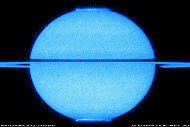 Enormous mile-high tsunamis of icy particles are moving around one of Saturn's rings, researchers say.
Enormous mile-high tsunamis of icy particles are moving around one of Saturn's rings, researchers say. The waves are created by one of Saturn's moons, Titan, whose gravitational pull yanks the particles of Saturn's inner C ring upward, creating huge peaks and gaps.
"It's a little bit like a tsunami propagating away from an earthquake fault," Phillip Nicholson of Cornell University said, according to National Geographic.
Enormous mile-high tsunamis of icy particles are moving around one of Saturn's rings, researchers say.
The waves are created by one of Saturn's moons, Titan, whose gravitational pull yanks the particles of Saturn's inner C ring upward, creating huge peaks and gaps.
"It's a little bit like a tsunami propagating away from an earthquake fault," Phillip Nicholson of Cornell University said, according to National Geographic.
Others seem to have no connection to a moon. What's more, the gaps seemed to change size, and even vanish periodically.
"It's become an increasing problem, as to what determines where these gaps are in the rings and what keeps the gaps open," Nicholson said, according to Wired.
The breakthrough came when observers began to consider the ring in three dimensions. Then they realized that there were peaks in the C ring.
Seen from different angles, these peaks could distort or even completely obscure the gaps, explaining the gaps' tendency to change shape and vanish from view.
"This and some other work suggests there might not be one explanation for gaps, there may be three or four or even more different dynamical circumstances that can give rise to these gaps," Nicholson said, according to National Geographic.
The C ring is the second innermost of the planet's seven rings.
By studying the planet's rings, scientists can gain insight into other stellar disks. Some stars are surrounded by disks that may eventually form planets.
"Saturn really is a wonderful, natural lab for understanding how the protoplanetary nebula might have evolved," said Linda Spilker, deputy project scientist at the Jet Propulsion Laboratory, according to Universe Today.

 Previous page
Previous page Back to top
Back to top







